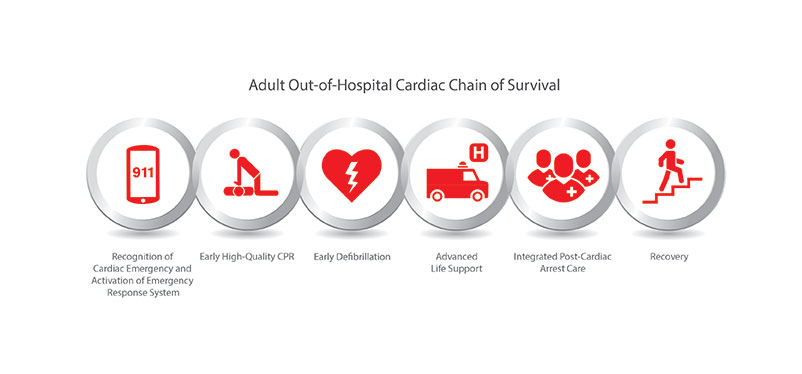-
What is CPR?
CPR stands for cardiopulmonary resuscitation. It can help save a life during cardiac arrest, when the heart stops beating or beats too ineffectively to circulate blood to the brain and other vital organs.
What Is the Purpose of CPR?
With a half-million cardiac arrests each year, CPR increases the likelihood of surviving cardiac arrest, when the heart stops beating or beats too ineffectively to circulate blood to the brain and other vital organs. It’s not just for healthcare workers and emergency responders. CPR can double or triple the chance of survival when bystanders take action. The Red Cross helps train you safely, effectively and confidently so you’re prepared for the moments that matter.
Why is CPR Important?
CPR should be used when you see someone who is unresponsive and is not breathing or only gasping. Having more bystanders trained in this simple skill can help save lives by putting more cardiac arrest victims within a few steps of lifesaving assistance.
What Are the Types of CPR?
- Hands-Only CPR: Hands-only CPR is an easy-to-learn skill that could save a life. It involves calling 9-1-1, sending someone for the AED if available and then giving continuous chest compressions. It only takes minutes to learn.
- CPR With Rescue Breaths: While Hands-only CPR can be lifesaving, learning full CPR is still very important. Getting trained in full CPR – combinations of chest compressions and rescue breaths – will increase your confidence and may enable you to help in other types of emergencies. Full CPR is ideal for all ages, and especially for people who are more likely to experience respiratory emergencies such as children and infants.
Why Learn CPR?
Learning how to perform CPR properly takes just a few short hours, but it can change a life forever. Red Cross CPR training classes give you the information and the skills you need to help adults, children and infants during cardiac emergencies. Whether you choose 100% in-person or blended learning CPR classes, our world-class instructors deliver the most up-to-date information that's engaging and effective, preparing you for the moments that matter.
Cardiac Arrest Chain of Survival
Cardiac arrest can happen anytime and anywhere. In these emergencies, the heart stops beating or beats too ineffectively to circulate blood to the brain and other vital organs. The cardiac arrest out-of-hospital chain of survival shows the steps necessary to take in order to improve chances of survival from cardiac arrest.

The 6 links in the adult out-of-hospital Chain of Survival are:
- Recognition of cardiac arrest and activation of the emergency response system (such as calling 9-1-1)
- Early CPR with an emphasis on chest compressions
- Rapid defibrillation
- Advanced resuscitation by Emergency Medical Services (EMS) and other healthcare providers
- Post-cardiac arrest care in the hospital
- Recovery (such as additional treatment, rehabilitation, and psychological support)
CPR/AED Classes
At the Red Cross, you can choose the type of class for your schedule – and the way you learn best. For those who want to become certified in CPR/AED, you can choose from three types of courses:
- In-person: Designed for those who learn best in a traditional classroom setting, our in-person courses combine lecture with hands-on skills sessions. This way, you can not only learn what CPR is, but you will be able to practice your skills with a certified instructor. If the course is completed with a passing grade, you'll receive a two-year certification.
- Online: Perfect for those who want the freedom to take self-paced courses, our online classes can help you learn what CPR is and how to perform the different types of CPR. However, online safety training courses do not allow you to demonstrate your skill proficiency to a certified instructor, and therefore your certification may not meet the requirements for workplace safety.
- Blended Learning: Our blended learning programs combine self-paced, interactive instruction and in-person skills sessions. That way, you can learn what CPR is, why CPR is important and how to perform it in theory and in practice. Additionally, because this option allows you to demonstrate your skills to a certified instructor, you can receive full certification with a passing score.
A Real-life Example of Why CPR Is Important
Why Train With the Red Cross
Reid Heiser, Life Saver
One week after 17-year-old Reid completed his Red Cross CPR training, he needed to use it. In November 2011, Reid saved the life of Jim Hammer after he collapsed at the recreation center where Reid worked. Now friends, they share their story.Red Cross Training Matters
For more than a century, we've prepared people to respond to emergencies of all sizes - from the everyday to the large disaster. Join the millions we train every year and learn the skills that can save a life."Without my friend's training, I would not be here"
- Watch Bre Dumke's Story"The first 7 minutes are critical"
- Watch More

